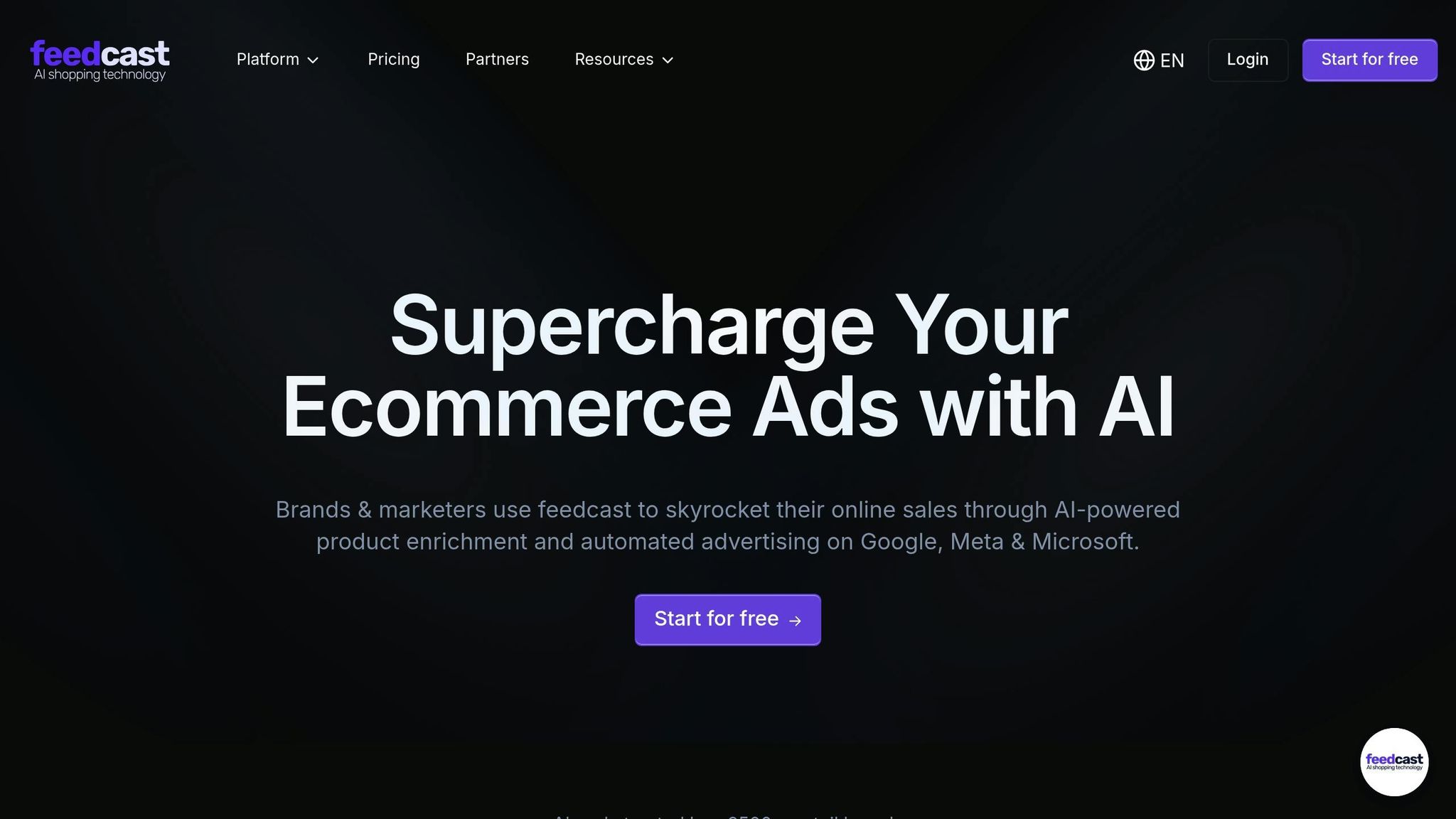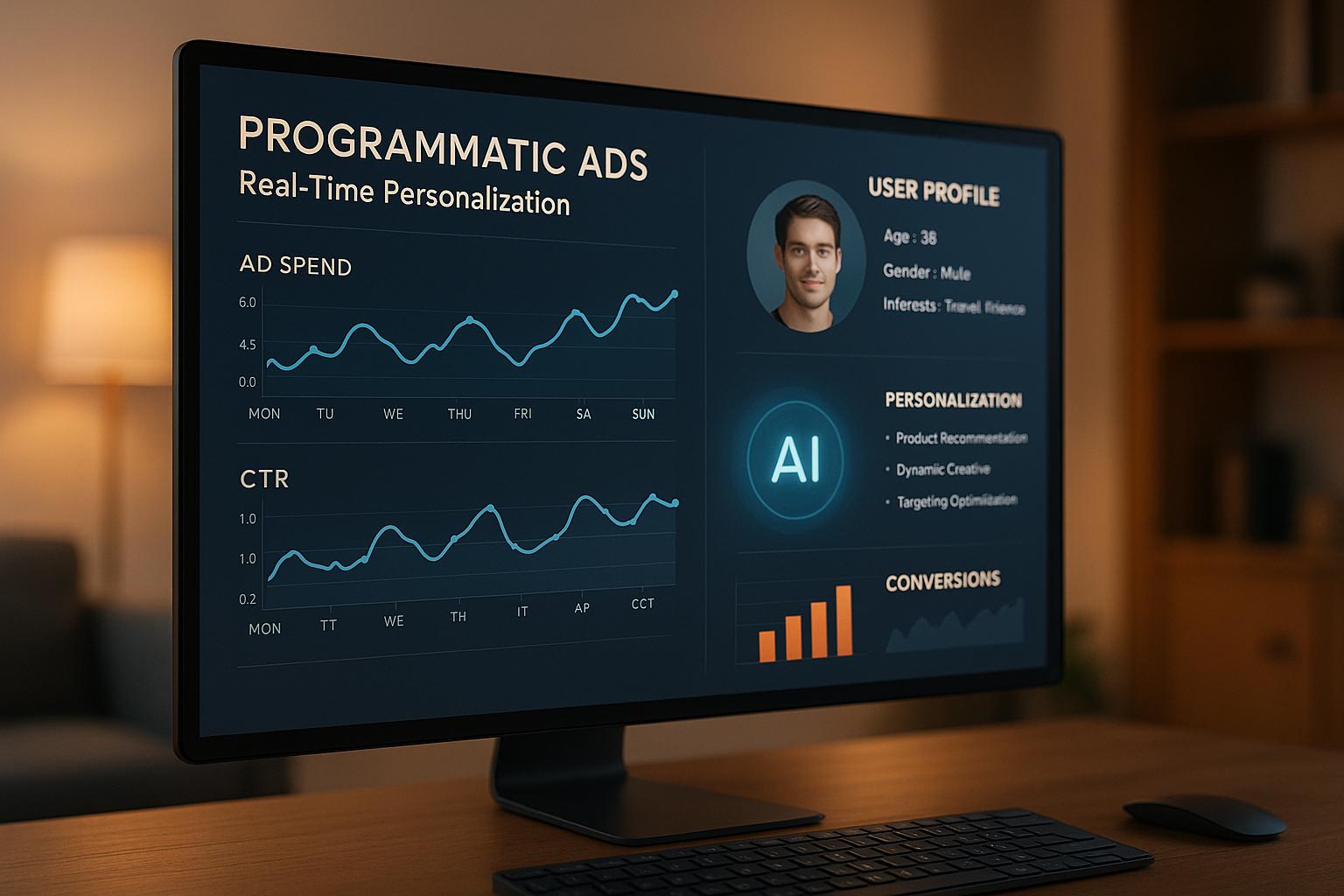Personalized Ads: Using Time-Sensitive Behavioral Data
In digital advertising, timing plays a crucial role in user engagement. By analyzing behavioral data, such as browsing patterns or abandoned carts, businesses can identify when users are most likely to interact with ads. This approach moves beyond static targeting, enabling real-time marketing based on user intent.
Platforms like Feedcast.ai stand out by combining e-commerce data with AI to deliver personalized ad experiences. Feedcast.ai integrates with platforms like Shopify, Google, and Meta, creating a unified system for campaign management. It optimizes ad timing, messaging, and product recommendations based on user behavior, boosting ad performance and ROI. This contrasts with older tools, which often operate in silos and require more manual effort.
Key Takeaways:
- Behavioral data reveals not just what users do but when they do it, improving ad relevance.
- Feedcast.ai centralizes data and automates cross-channel ad optimization, saving time and improving results.
- Older tools focus on specific tasks but often lack integration, leading to fragmented insights.
Ultimately, platforms like Feedcast.ai simplify campaign management and improve ad effectiveness, while older tools may suit businesses with specific technical needs or larger teams.
How Does User Behavior Affect Personalized Social Media Marketing? - Everyday-Networking
1. Feedcast
Feedcast.ai brings together behavioral data from e-commerce platforms and advertising channels, using AI to transform this information into actionable ad strategies.
Data Collection and Integration
Feedcast.ai integrates directly with popular e-commerce platforms like Shopify, WooCommerce, and Prestashop, collecting real-time data on product interactions, transactions, and browsing behavior. It also supports file imports in formats like Google Sheets, CSV, and XML, making data management more flexible.
What makes this system stand out is its unified data pipeline, which connects advertising platforms such as Google, Meta (Facebook and Instagram), and Microsoft Ads. This integration creates a comprehensive view of user behavior across both e-commerce sites and ad channels. For example, if a customer abandons their cart at 2:00 PM and interacts with a retargeting ad later that evening, Feedcast.ai captures both events. This insight into timing and behavior helps optimize future campaigns.
Additionally, the platform uses AI to refine product titles, descriptions, and attributes automatically. This enriched product data improves the accuracy of behavioral insights, ensuring better tracking of user interests and engagement patterns.
Personalization Mechanisms
Feedcast.ai takes its robust data integration a step further by using AI to deliver personalized ad experiences. By analyzing recent product views, purchase history, and engagement patterns, it generates dynamic ad copy tailored to individual user interests.
For instance, if someone browses winter jackets during lunch, Feedcast.ai prioritizes ads for cold-weather gear and adjusts the timing for optimal delivery. Its smart targeting strategies cater to both acquiring new customers and retargeting existing ones.
Personalization isn’t limited to product recommendations. Feedcast.ai customizes messaging, promotions, and even visuals based on user behavior. A shopper who tends to browse in the evenings might see different promotions than someone who shops during their morning commute.
Campaign Optimization and Analytics
Feedcast.ai continuously improves campaign performance through real-time analytics. Its unified dashboard tracks key metrics like click-through rates, engagement times, conversion rates, and customer lifetime value across all connected channels. The AI analyzes this data in real time to identify high-value customers and suggest campaign adjustments.
Beyond basic metrics, the platform offers custom reporting and detailed performance segmentation. This allows marketers to pinpoint not just which ads are successful, but also when they perform best and for which audience segments.
Research shows that leveraging behavioral data can lead to a 56% boost in campaign performance and a 48% improvement in segmentation accuracy. Feedcast.ai taps into this data-driven approach to help businesses maximize ROI through precise targeting and smarter ad spend.
Ease of Multi-Channel Management
Running campaigns across multiple platforms often means dealing with separate interfaces, reporting tools, and optimization systems. Feedcast.ai simplifies this process by centralizing all ad accounts in one place. This streamlined system makes it easier to create, monitor, and manage budgets across Google, Meta, and Microsoft Ads.
The unified dashboard allows marketers to align messaging and maintain a consistent brand voice across channels. If behavioral data reveals a shift in customer preferences or timing, campaigns can be adjusted across all platforms without needing to navigate multiple tools.
As a certified Google CSS (Comparison Shopping Service) partner, Feedcast.ai also offers cost-saving advantages for Google Shopping campaigns. With subscription plans starting at $0/month, the platform is accessible to businesses of all sizes. This centralized, multi-channel approach makes managing ad campaigns more efficient while delivering better results, setting Feedcast.ai apart from other time-sensitive personalization tools.
2. Other Time-Sensitive Ad Personalization Tools
While Feedcast.ai offers a unified solution, many older tools operate in isolation, addressing specific aspects of ad personalization. These tools often focus on particular areas like behavioral data collection or real-time campaign adjustments, each bringing its own set of benefits and challenges.
Data Collection and Integration
Legacy tools typically rely on first-party cookies and pixel tracking to monitor actions like page views, product interactions, and cart abandonments. However, integrating data from non-Google sources often results in fragmented insights. Social media platforms also track user engagement, but recent privacy updates have reduced the accuracy of these methods.
Server-side tracking has emerged as a more secure alternative to cookie-based methods. These systems gather behavioral data directly from e-commerce platforms and send it to ad networks via secure APIs. While this approach is more privacy-compliant, it demands a higher level of technical expertise to implement and maintain.
Personalization Mechanisms
Most traditional tools use rule-based retargeting, which serves ads for products users viewed within a set timeframe, usually between 7 and 30 days. However, these tools often lack flexibility in customizing messaging or timing.
Dynamic product ads are widely employed, automatically pulling product details and recent user behavior to create ad content. Despite this, personalization often stops at product selection, with messaging and promotional strategies remaining uniform across user groups. This is where Feedcast.ai stands out, offering AI-powered customization that tailors not just product recommendations but also messaging, timing, and promotions based on individual user behavior.
Email marketing platforms like Klaviyo and Mailchimp integrate with e-commerce systems to send targeted emails. For instance, they can trigger abandoned cart reminders or suggest products based on browsing history. While effective for email campaigns, these insights rarely translate seamlessly into paid advertising strategies on other platforms.
Programmatic advertising platforms use real-time bidding to serve ads tailored to immediate behavioral cues, such as user activity, location, or device type. While these systems offer advanced personalization, they often require specialized knowledge and higher budgets, making them less accessible to smaller businesses.
Campaign Optimization and Analytics
Traditional tools often rely on manual reviews to adjust campaigns, which can miss rapid shifts in user behavior. Some automated systems, like Google Ads Smart Bidding or Facebook's Campaign Budget Optimization, adjust bids and budgets in real time. While these tools improve efficiency, they typically operate within a single platform and don’t account for cross-channel user behavior or broader e-commerce metrics. Feedcast.ai addresses this by offering a unified dashboard that monitors performance across multiple channels simultaneously.
Attribution modeling continues to be a challenge for many tools. Most rely on last-click attribution, which overlooks the entire customer journey and can misallocate budgets. Although more advanced attribution models exist, they often require complex setups and ongoing maintenance to remain effective.
Ease of Multi-Channel Management
Managing campaigns across multiple platforms often involves juggling different tools, leading to fragmented insights and manual adjustments.
Third-party tools can centralize reporting and campaign management to some extent. However, they often lack deep integration with e-commerce platforms, meaning behavioral data from online stores doesn’t automatically inform ad strategies across all channels. This gap frequently requires manual data transfers, complicating efforts to maintain consistency.
Budget allocation across platforms is another pain point. Without unified behavioral insights, marketers may struggle to determine which channels perform best for specific audiences or timeframes. This can lead to inefficient spending and missed opportunities for cross-channel optimization.
Additionally, maintaining consistent tracking and personalization across platforms is technically demanding. Each platform has unique requirements for data formatting, audience creation, and campaign setup. For smaller businesses, the resources needed to manage these complexities may be out of reach. These challenges highlight the benefits of centralized platforms that streamline data management and automation.
sbb-itb-0bd1697
Advantages and Disadvantages
Building on the earlier discussion about platform capabilities, let’s dive into the pros and cons of using Feedcast.ai versus traditional tools. Knowing the trade-offs in time-sensitive behavioral advertising can help guide your choice of marketing technology.
Feedcast.ai Advantages

Feedcast.ai simplifies campaign management by eliminating the data fragmentation often found in traditional setups. Instead of juggling separate tools for Google Ads, Facebook campaigns, and product feed optimization, you can manage everything from one dashboard.
One standout feature is its AI-powered product feed enrichment, which enhances product titles, descriptions, and attributes automatically. Poorly optimized product data is a common issue that can hurt ad visibility and click-through rates. Research even shows that behavioral advertising achieves much higher click-through rates compared to non-targeted ads[1].
Another strength is its real-time cross-channel optimization. Unlike traditional tools that often operate in silos, Feedcast.ai dynamically adjusts bidding strategies and budget allocations based on live behavioral signals across platforms. This unified approach ensures that successful audiences on one channel are effectively leveraged across others.
Additionally, Feedcast.ai’s pricing model - with a free tier and scalable plans - opens the door for small e-commerce businesses to access advanced behavioral targeting without hefty upfront costs.
Feedcast.ai Disadvantages
Transitioning to Feedcast.ai can come with a learning curve. While the unified dashboard simplifies management in the long run, setting it up and getting used to its AI-driven features might require extra training.
The platform’s reliance on integrations means that any temporary disruptions in API connections with Google, Meta, or Microsoft could impact campaign performance. This creates a single point of potential failure compared to managing platforms independently.
Lastly, AI-driven personalization may feel less transparent to marketers who prefer hands-on control over every campaign detail. Troubleshooting specific performance issues can also be trickier in such cases.
Traditional Tools Advantages
Traditional tools shine in specialized areas. For instance, email platforms often use behavioral triggers to reduce cart abandonment by 25% and boost repeat purchases by 15%[2].
These tools also excel at leveraging first-party data, offering deep integration with specific advertising channels. Features like Google Ads Smart Bidding or Facebook’s Campaign Budget Optimization can deliver strong results within their respective ecosystems.
Another benefit is the high level of control traditional tools offer. Experienced marketers can fine-tune campaigns with detailed settings and manual overrides.
Traditional Tools Disadvantages
One of the biggest challenges with traditional tools is data fragmentation. Insights from one platform rarely inform strategies on others, leading to inconsistent messaging and missed opportunities for cross-channel optimization. And while targeted ads can improve response rates, performance can drop if consumer data access is restricted across platforms[4].
Managing multiple tools also increases the manual workload. Each platform requires separate workflows for campaign optimization, audience creation, and performance analysis - consuming a lot of time.
Attribution remains another hurdle. Relying on last-click attribution can fail to account for the full customer journey, leading to budget misallocations of up to 30–40% in multi-touch scenarios[4].
Finally, maintaining consistent privacy controls can be difficult when working with multiple vendors, each with their own data handling practices.
Comparison Overview
| Aspect | Feedcast.ai | Traditional Tools |
|---|---|---|
| Setup Complexity | Moderate initial setup; easier long-term | Low per tool, but high overall complexity |
| Cross-Channel Insights | Unified behavioral data analysis | Fragmented; manual correlation needed |
| Time Investment | Reduced management time | High ongoing manual effort |
| Pricing Structure | Free tier with scalable plans | Varies widely; usage-based |
| Attribution Accuracy | Cross-platform attribution modeling | Limited to last-click |
| Privacy Management | Centralized compliance controls | Multiple vendor relationships |
| Customization Level | AI-driven with some override options | High granular control |
| Technical Expertise | Moderate | Ranges from low to very high |
Risk Considerations
Both approaches come with risks, especially when it comes to over-personalization. Ads that are overly targeted or feel intrusive can hurt purchase intentions and damage brand perception[3]. Striking the right balance between relevance and user comfort is key.
Consumer trust also hinges on transparency in data use and clear privacy options. Behavioral advertising tends to work best when users are further along in the purchase funnel, making timing and context critical[3]. Whether using a unified platform like Feedcast.ai or traditional tools, it’s essential to prioritize user consent and provide easy opt-out mechanisms.
Ultimately, the choice between an integrated solution like Feedcast.ai and traditional tools depends on your business size, technical resources, and goals. Companies looking for efficiency and cross-channel optimization may find Feedcast.ai more appealing, while those needing specialized functionality might lean toward traditional tools.
Conclusion
When it comes to time-sensitive behavioral advertising, e-commerce businesses face two main paths: opting for an all-in-one platform like Feedcast.ai or sticking with a more traditional, fragmented setup. The right choice boils down to factors like your business's size, available technical resources, and overall growth goals.
For many, Feedcast.ai stands out as a practical solution, offering efficiency and scalability. Its ability to manage multichannel advertising across major platforms like Google, Meta, and Microsoft Ads simplifies campaign oversight and reduces the hassle of juggling multiple tools.
That said, traditional tools might still work for large enterprises with robust technical teams and highly specific needs. However, managing separate workflows for campaign optimization and performance tracking on various platforms can be incredibly time-consuming and may divert attention from broader growth strategies.
One crucial consideration is the potential downside of over-personalization. Striking the right balance between tailoring ads and respecting user comfort is key. Regardless of whether you choose Feedcast.ai or another route, maintaining transparency in how data is used and offering clear privacy options is vital. This approach not only safeguards your brand's reputation but also helps turn data into actionable, real-time advertising success.
FAQs
How does Feedcast.ai use AI to create personalized ads based on user behavior?
Feedcast.ai taps into advanced AI to study real-time user behavior, including browsing patterns and past interactions, to create highly customized ad experiences. By analyzing this data, the platform crafts personalized ad copy and fine-tunes targeting strategies to make sure ads strike a chord with each user.
This method boosts relevance, drives better engagement, and increases conversion rates, enabling businesses to connect with their audience on a deeper level.
What challenges might businesses encounter when adopting Feedcast.ai for ad management?
Making the switch to a platform like Feedcast.ai can present some hurdles at the start. For one, businesses might need to tweak their current workflows and invest time in training their teams to get the most out of the platform’s features. Another key step is integrating existing data, which can take time to align with the system’s capabilities.
It’s also crucial for companies to review their data privacy policies to ensure they meet legal and ethical standards when working with AI-driven tools. With thoughtful planning and the right support, these challenges can be addressed, paving the way for businesses to take advantage of Feedcast.ai's efficient advertising tools.
How does combining e-commerce data with advertising platforms make personalized ads more effective?
Integrating e-commerce data with advertising platforms takes personalized advertising to the next level. By tapping into real-time insights - like customer behavior, purchase history, and product interactions - businesses can craft ads that truly connect with their target audience. This approach not only grabs attention but also drives higher engagement and conversions.
Another major perk? Automation. This integration allows for automatic updates to product feeds and ad settings. That means your ads stay aligned with your current inventory and evolving customer preferences. The outcome? Ads that feel more relevant, perform better, and deliver a stronger return on investment (ROI).
Geoffrey G.




